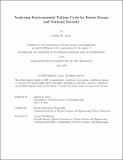| dc.contributor.advisor | Wainwright, Haruko Murakami | |
| dc.contributor.author | Arias, Liliana R. | |
| dc.date.accessioned | 2025-07-07T17:38:31Z | |
| dc.date.available | 2025-07-07T17:38:31Z | |
| dc.date.issued | 2025-05 | |
| dc.date.submitted | 2025-05-19T17:37:10.137Z | |
| dc.identifier.uri | https://hdl.handle.net/1721.1/159916 | |
| dc.description.abstract | Although tritium is a sought-after isotope of hydrogen for fusion fuel, it is important to consider the environmental impacts of its release into the environment. In order to prepare for the elevated tritium releases that may result from commercial fusion power, yearly tritium releases from different types of nuclear facilities are compiled, with an emphasis on fusion reactors. Atmospheric modeling using HYSPLIT and a Gaussian Plume model is then conducted in order to better understand current and future global tritium sources and concentrations and their release pathways in the environment. Despite elevated tritium levels near major sources, most emissions remained within regulatory bounds, although proximity to facilities still matters. | |
| dc.publisher | Massachusetts Institute of Technology | |
| dc.rights | In Copyright - Educational Use Permitted | |
| dc.rights | Copyright retained by author(s) | |
| dc.rights.uri | https://rightsstatements.org/page/InC-EDU/1.0/ | |
| dc.title | Analyzing Environmental Tritium Cycle for Fusion Energy
and National Security | |
| dc.type | Thesis | |
| dc.description.degree | S.B. | |
| dc.contributor.department | Massachusetts Institute of Technology. Department of Nuclear Science and Engineering | |
| mit.thesis.degree | Bachelor | |
| thesis.degree.name | Bachelor of Science in Nuclear Science and Engineering | |
